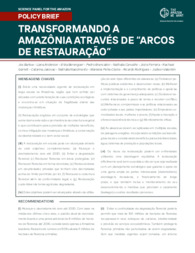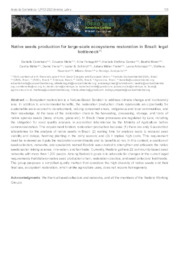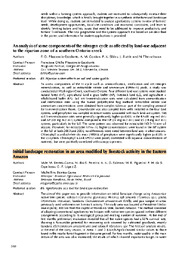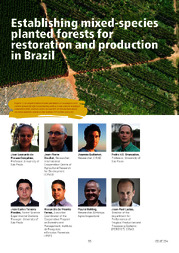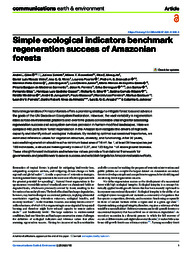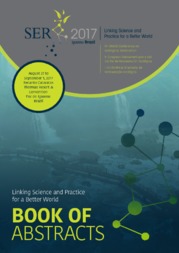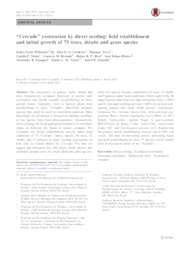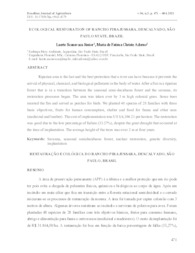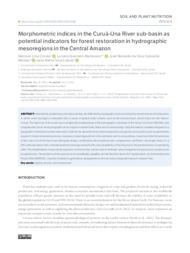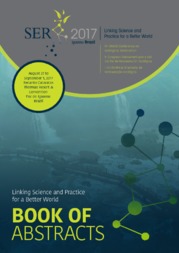Search Publications
Filter by:
| Author(s): BARLOW, J.; ANDERSON, L.; BERENGUER, E.; BRANCALION, P.; CARVALHO, N.; FERREIRA, J. N.; GARRETT, R.; JAKOVAC, C.; NASCIMENTO, N.; PEÑA-CLAROS, M.; RODRIGUES, R.; VALENTIM, J. F. Esta publicação aborda a necessidade de uma restauração em larga escala na Amazônia, apontando algumas soluções. |
| Author(s): CELENTANO, D.; MALTA, E.; FERRAGUTTI, A.; GOMES, A. S.; MURER, B.; MOTTA, C.; VIEIRA, D. L. M.; SCHMIDT, I. B.; FREIRE, J. M.; ANTONIAZZI, L.; REZENDE, M.; ALVES, M.; JUNQUEIRA, R.
|
| Author(s): BENTES, M. P. de M.; PEREIRA, N. dos S.; SALMAN, A. K. D.; FIGUEIRO, M. R.; CAPELASSO, P. H. da S.; ZAMORA LÓPEZ, G. F. The aim of this paper was to provide information on initial lanscape change using Amazonian native tree species: sobrasil (Colubrina glandulosa Perkins), ipê amarelo (Tabebuia sp.), jatobá (Hymenaea r... ... |
| Author(s): GONÇALVES, J. L. de M.; BOUILLET, J.; GUILLEMOT, J.; BRANCALION, P. H. S.; MENDES, J. C. T.; FERRAZ, A. de V.; BEHLING, M.; LACLAU, J. Tree plantations have considerable importance for the Brazilian forest sector today. Brazil harbours the largest area of forest plantations in Latin America. Most of these plantations are industrial m... ... |
| Author(s): GILES, A. L.; SCHIETTI, J.; ROSENFIELD, M. R.; MESQUITA, R. C.; VIEIRA, D. L. M.; VIEIRA, I. C. G.; POORTER, L.; BRANCALION, P. H. S.; PEÑA-CLAROS, M.; SIQUEIRA, J.; OLIVEIRA JUNIOR, L.; ESPÍRITO-SANTO, M. M. do; SARMENTO, P. S. de M.; FERREIRA, J. N.; BERENGUER, E.; BARLOW, J.; ELIAS, F.; CASSOL, H. L. G.; SILVA, R. C.; RIBEIRO, S. C.; MEDEIROS, N.; JUNQUEIRA, A. B.; MASSOCA, P.; FERREIRA, M. J.; GASTAUER, M.; FERREIRA, L. V.; ALMEIDA, D. R. A. de; ARAGÃO, L. E. O.; JAKOVAC, C. C. Natural regeneration of Amazon forests offers a promising strategy to mitigate forest loss and advance the goals of the UN Decade on Ecosystem Restoration. However, the vast variability in regeneratio... ... |
| Author(s): BENINI, R. de M.; LENTI, F. E. B.; TYMUS, J. R. C.; SILVA, A. P. M. da; ISERNHAGEN, I. Aiming to subsidize actions and policies for the development of large-scale restoration in Brazil, the Institute for Applied EconomicResearch and The Nature Conservancy, started an important study to... ... |
| Author(s): PELLIZZARO, K. F.; CORDEIRO, A. O. O.; ALVES, M.; MOTTA, C. P.; REZENDE, G. M.; SILVA, R. R. P.; RIBEIRO, J. F.; SAMPAIO, A. B.; VIEIRA, D. L. M.; SCHMIDT, I. B.
|
| Author(s): SCANAVACA JUNIOR, L.; ADORNO, M. F. C. Abstract: Riparian area is the last and the best protection that a river can have because it prevents the arrival of physical, chemical, and biological pollutants in the body of water. After a fire in... ... |
| Author(s): CORREA, D. L.; MARTORANO, L. G.; MORAES, J. R. da S. C. de; LISBOA, L. S. S. Watersheds are planning units because they are delimited by topographic divisions formed by a main river and its tributaries, in which water drainage is channeled into a course of greater water volume... ... |
| Author(s): TYMUS, J. R. C.; LENTI, F. E. B.; BENINI, R. de M.; SILVA, A. P. M. da; ISERNHAGEN, I. Recently, the Brazilian government committed to restore and reforest 12 million hectares of forests until 2030 (Nationally DeterminedContribution - NDC). Seeking to strategically subsidize large-scale... ... |
Observation
Some of Embrapa's publications are published as ePub files. To read them, use or download one of the following free software options to your computer or mobile device. Android: Google Play Books; IOS: iBooks; Windows and Linux: Calibre.
Access other publications
Access the Agricultural Research Database (BDPA) to consult Embrapa's full library collection and records.
Visit Embrapa Bookstore to purchase books and other publications sold by Embrapa.

